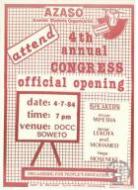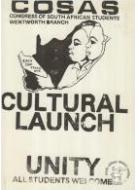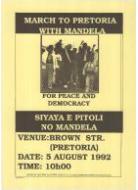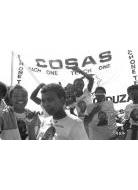What is wrong with our education? Our education is unequal because:
whereas the government spends R931,00 per year on every white child, it spends only R253,00 and R 139,00 per year on coloured and african children;
whereas one teacher in a white school caters for every 18 pupels (sic), in black schools one teacher caters for 39 pupels (sic).
also about half the black matriculants who wrote their exams last year failed because of the inferior education they received.
The revival of youth politics and resistance in the 1980s had much to do with the formation of two new student organisations in 1979:
- the Congress of South African Students (COSAS) – represented students at schools and colleges
- the Azanian Students Organisation (AZASO) – represented university students
COSAS which focused on the crisis in education in schools, aimed to fight against Bantu Education and to normalise relations between pupils, teachers and parents, which had significantly broken down since the school boycotts in the late 1970s. COSAS believed in non-racialism and adopted the Freedom Charter. It was willing to work with any progressive organisations with similar beliefs to theirs.
The Azanian Students’ Organisation (AZASO) was an offshoot of the Azanian People’s Organisation (AZAPO), which was relaunched in 1979. AZASO organised students at a university level. It was however weakened by splits and divisions in the membership over ideology. Some members argued the importance of following black consciousness, while others believed in non-racialism. AZASO did eventually adopt the Freedom Charter as well.
In 1980 and 1983 there were two major urban school boycotts. Following the Soweto uprising, the government had agreed not to introduce Afrikaans as the language of instruction. However, little else had been done to improve education. Schools remained under-resourced, classrooms were over-crowded and there was a significant drop in standards as a result of hundreds of teachers resigning after 1977. The boycotts began in coloured schools in the Western Cape but rapidly spread throughout the country. ‘Liberation before education’ became the rallying cry, and gained support in many townships. There were also school protests in the rural areas between 1985 and 1986. Schools were closed and thousands of students and teachers were arrested.
..for us to wage a successful struggle, each one of us as a student needs to contribute in building our genuine student organisations. Organising ourselves into these structure will ensure that we all participate meaningfully through our daily lives in concrete struggle for a Democratic, nonracial, free and compulsory education for all.
June 16, Education in Crisis - pamphlet issued by AZASO and COSAS
COSAS played an important role in these boycotts. COSAS believed that school boycotts were having a negative impact on the future of the youth and eventually negotiated a suspension of the boycotts in African schools. In order to show their commitment to education and to popularise their message, COSAS launched the Education Charter campaign. The charter endorsed the education principles in the Freedom Charter. COSAS also organised tutoring programmes to help school students to catch up with their studies. COSAS also played an important role in the formation of the United Democratic Front (UDF).
However, no reform of education took place and in 1984, school boycotts resumed. This time, COSAS tried to coordinate student demands and link them to the wider struggles that were taking place against apartheid. As COSAS increased its profile, the government saw the organisation as a threat and banned COSAS in August 1985.
Exhibitions in the classroom
READING THE PAST
Read the source dealing with the crisis in education and then answer the following questions:
- This document was issued by COSAS and AZASO in the 1980s. What do they identify as the crisis in education at that time?
- COSAS and AZASO tried to unify students throughout the country with the slogan “An Injury to One is an Injury to All!” What do you think they meant by this slogan and do you think it is effective?
- What is the tone of this document? Explain your answer by using examples from the text.
- Is this document biased in any way? Find examples in the text to justify your answer.
Making connections between past and present
Read the extracts from the Freedom Charter.
When South Africa achieved its freedom, the new government pledged to uphold the principles of the Freedom Charter when governing the country. Draw two columns on a page. One heading says Achieved and the other says Not Achieved. Under the relevant columns, identify which principles have been achieved today and which have not. What do your findings show about the state of education today?


















